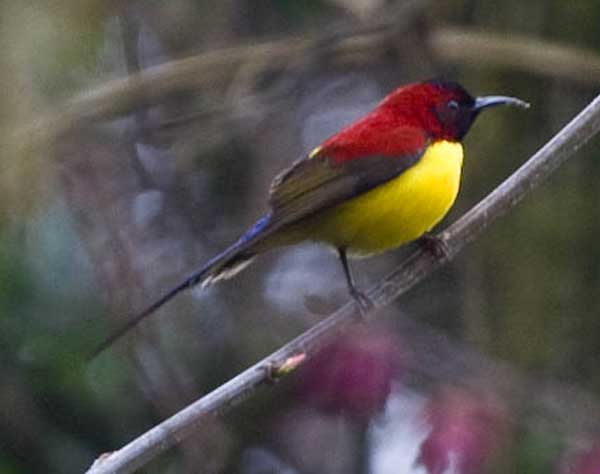
Aethopyga gouldiae (*)
Superregnum: Eukaryota
Regnum: Animalia
Subregnum: Eumetazoa
Cladus: Bilateria
Cladus: Nephrozoa
Superphylum: Deuterostomia
Phylum: Chordata
Cladus: Craniata
Subphylum: Vertebrata
Infraphylum: Gnathostomata
Superclassis: Tetrapoda
Cladus: Reptiliomorpha
Cladus: Amniota
Classis: Reptilia
Cladus: Eureptilia
Cladus: Romeriida
Subclassis: Diapsida
Cladus: Sauria
Infraclassis: Archosauromorpha
Cladus: Crurotarsi
Divisio: Archosauria
Subsectio: Ornithodira
Subtaxon: Dinosauromorpha
Cladus: Dinosauria
Ordo: Saurischia
Cladus: Eusaurischia
Cladus: Theropoda
Cladus: Neotheropoda
Infraclassis: Aves
Ordo: Passeriformes
Subordo: Passeri
Infraordo: Passerida
Superfamilia: Passeroidea
Familia: Nectariniidae
Genus: Aethopyga
Species: Aethopyga gouldiae
Subspecies: A. g. annamensis - A. g. dabryii - A. g. gouldiae - A. g. isolata
Name
Aethopyga gouldiae (Vigors, 1831)
References
Proceedings of the Committee of Science and Correspondence of the Zoological Society of London Pt1 no.4 p. 44
Vernacular names
English: Gould's Sunbird
français: Souimanga de Gould
Mrs. Gould's sunbird (Aethopyga gouldiae) is a sunbird species native to forests and shrublands from the southern foothills of the Himalayas to Southeast Asia.
Taxonomy
Mrs.Gould's sunbird was first described by Irish zoologist Nicholas Vigors in 1831 and named after British bird artist Elizabeth Gould.[2][3]
Four subspecies have been described:[4][5][6]
A. g. annamensis (Robinson & Kloss, 1919)
A. g. dabryii (J.Verreaux, 1867)
A. g. gouldiae (Vigors, 1831) (the nominate subspecies)
A. g. isolata (E.C.S.Baker, 1925)
The species is regarded as closely related to the green-tailed sunbird.[7]
Description
Mrs.Gould sunbird is a small sunbird. It has a down-curved and pointed beak, typical for a nectar feeder. The iris of the eye is usually deep brown, and the tarsus is black.
The male Mrs.Gould's sunbird is bright and colourful. The forehead to crown, supercilium and throat of the sunbird is deep violet. The lore, the auriculars and the malar region, the nape, mantle and side is bright red to deep scarlet. Bright blue patterns may present on the auricular and the side. The coverts and wingbars to the primary feathers are brown or olive green. The belly and vent are yellowish-green. The covert tail covert is blight blue and fades to dark purple at the tip of the tail.
The female is dull in colour compare to the male. The female is cover by deep olive green on the dorsal side and the greyish-yellow on the ventral side.
The colour and pattern may differential in different subspecies. For example, the breast of A. g. dabryii is purely scarlet, and A. g. gouldiae has a bright yellow breast, with or without a red stripe.[4]
The male weighs 4-12 g and measures 131-160 mm. Wing length is 51-58 mm, tail length is 64-88mm, and the tarsus is 13-15.5 mm in length. The female weighs 5-8 g and is between 91-111 mm in length. The wing is 45-54. The tail is 30.5-40 mm in length, and the tarsus is 12-16 mm in length. Both sexes have a beak 13-17 mm in length.[4][5]
Distribution and habitat
Mrs. Gould's sunbird is widely distributed in Bangladesh, Bhutan, Laos, Myanmar, Nepal, Thailand, India, Vietnam and Southern China.[1][5] It is found in the evergreen broad-leaved forest, monsoon forest and deciduous broad-leaved forest at 1000-3500 m above sea-level. It is also occasionally found in orchards and bamboo forest within its range. There is a non-breeding population in Hong Kong.[5].=
Ecology
Diet
As a typical sunbird, Mrs. Gould's sunbird feeds on nectar. The elongated and tubular tongue is modified for sucking the nectar for tube-shape flowers. It also takes small invertebrates. Diet in Sichuan and Yunnan was found to include spiders, small beetles and hemipteran nymphs.[5]
Behaviour
Mrs. Gould's sunbird is generally resident but may undertake small-scale seasonal migrations.[8] It is usually seen solitary or in pairs although temporary groups of 3-5 or even more than 10 individuals can form. It moves quickly and flies for short distances. Calls include a high thin "tzeeee" and sharp "tzit".[9]
Reproduction
The breeding period of Mrs. Gould's sunbird is April to June. Females nest around mid-April. The nest is built of moss, grass, plant fibers and spiderwebs. It is 15-18 cm long and 10-11.5 cm wide, and usually build in deciduous board-leaved forest at 1000-3000m above sea level. In the breeding season, the males court the females sunbird with a mating call 'zhai-zhai-zhai'.[4] Clutch size is 2-3 eggs, 13.5-15.3 mm x 10.5-11.5 mm in size. The eggs are white and usually have reddish brown spots. Incubation lasts for about 2 weeks, and chicks fledge after 15-16 days. In this period, both parents care for the chicks. The adults feed nectar to the young chicks by regurgitation at the beginning; later on invertebrates are increasingly provided.[10]
Conservation
The species is listed as Least Concern in the IUCN Red List.[1]
Mrs. Gould's sunbird is not on the list of endangered and protected species of China. However, it is on the List of Wild Animal that Protected by PRC with Beneficial and High Value of Economy and Science.[11]
References
BirdLife International (2016). "Aethopyga gouldiae". IUCN Red List of Threatened Species. 2016: e.T22718077A94565475. doi:10.2305/IUCN.UK.2016-3.RLTS.T22718077A94565475.en. Retrieved 15 November 2021.
Lederer, Roger J. (2019). The Art of the Bird: The History of Ornithological Art Through Forty Artists. Chicago, IL: University of Chicago Press. p. 101. ISBN 978-0-226-67505-3.
Gill, Frank B.; Wright, Minturn T. (2006). Birds of the World: Recommended English Names. Princeton University Press. ISBN 978-0-691-12827-6.
赵正阶 (2001). 中国鸟类志: 雀形目. 下册 (in Chinese). 吉林科学技术出版社. ISBN 978-7-5384-2407-2.
"中国动物志 : 鸟纲. 第十三卷. 雀形目(山雀科-绣眼鸟科)". book.sciencereading.cn. Retrieved 2020-10-13.
"ITIS Standard Report Page: Aethopyga gouldiae". www.itis.gov. Retrieved 2020-10-13.
Wang, Ning; Liang, Bin (2016-07-03). "Complete mitochondrial genome of a sunbird, Aethopyga gouldiae (Aves: Passeriformes), the first representative of Nectariniidae". Mitochondrial DNA Part A. 27 (4): 2356–2358. doi:10.3109/19401736.2015.1025262. ISSN 2470-1394. PMID 25990041. S2CID 207579660.
"蓝喉太阳鸟 - 中国自然保护区生物标本资源共享平台". www.papc.cn. Retrieved 2020-10-13.
"Mrs. Gould's Sunbird - eBird". ebird.org. Retrieved 2020-10-13.
刘九江 (2017). "蓝喉太阳鸟". 林业与生态 (2): 45.
"List of Wild Animal that Protected by PRC with Beneficial and High Value of Economy and Science". Ministry of Natural Resource of the People's Republic of China. 2020-10-13.
Retrieved from "http://en.wikipedia.org/"
All text is available under the terms of the GNU Free Documentation License

